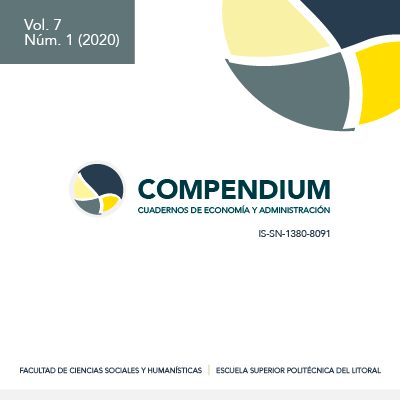MODELOS DE PREDICCIÓN DE DESERCIÓN DE CLIENTES PARA UNA ADMINISTRADORA DE FONDOS ECUATORIANA
##plugins.themes.bootstrap3.article.main##
Resumen
La existencia de una empresa está justificada por sus clientes, quienes son considerados como los activos más importantes. Ante mercados más competitivos y donde las necesidades de los clientes son cada vez más exigentes, las empresas buscan eficiencia en el uso y el análisis de datos. Perder clientes es más costoso que atraer nuevos clientes. El estudio sobre el comportamiento del cliente, particularmente su deserción, se ha convertido en una necesidad imperante dentro del ámbito empresarial. En la presente investigación se emplean técnicas de minería de datos para construir modelos de predicción de deserción de clientes, los cuales pueden ser aplicados dentro del mercado de desintermediación financiera. Los modelos estadísticos usados son: Árboles de decisión, bosques aleatorios y regresión logística, estos son evaluados en términos de precisión mediante área debajo de la curva de características de operación del receptor (AUC). La evaluación de los resultados, muestran que el bosque aleatorio tiene un mejor rendimiento que los otros modelos aplicados en el estudio.
Palabras clave
##plugins.themes.bootstrap3.article.details##
Aquellos autores/as que tengan publicaciones con esta revista, aceptan los términos siguientes:
- Los autores/as conservarán sus derechos de autor y garantizarán a la revista el derecho de primera publicación de su obra, el cuál estará simultáneamente sujeto a la Licencia de reconocimiento de Creative Commons que permite a terceros compartir la obra siempre que se indique su autor y su primera publicación esta revista.
- Los autores/as podrán adoptar otros acuerdos de licencia no exclusiva de distribución de la versión de la obra publicada (p. ej.: depositarla en un archivo telemático institucional o publicarla en un volumen monográfico) siempre que se indique la publicación inicial en esta revista.
- Se permite y recomienda a los autores/as difundir su obra a través de Internet (p. ej.: en archivos telemáticos institucionales o en su página web) antes y durante el proceso de envío, lo cual puede producir intercambios interesantes y aumentar las citas de la obra publicada. (Véase El efecto del acceso abierto).

Este obra está bajo una licencia de Creative Commons Reconocimiento 4.0 Internacional
Citas
Ahna, J.-H., Hana, S.-P., & Lee, Y.-S. (2006). Customer churn analysis: Churn determinants and mediation effects of partial defection in the Korean mobile telecommunications service industry. Telecommunications Policy, 30(10), 552-568.
Bolton, R., Kannan, P., & Bramlett, M. (2000). Implications of Loyalty Program Membership and Service Experiences for Customer Retention and Value. Journal of the Academy of Marketing Science, 95-108.
Bong-Horng, C., Ming-Shian, T., & Cheng, S. (2007). Toward a hybrid data mining model for customer retention. Knowledge-Based Systems, 703-718.
Bose, I., & Chen, X. (2009). Hybrid Models Using Unsupervised Clustering for Prediction of Customer Churn. Journal of Organizational Computing & Electronic Commerce, 19(2), 133-151.
Buckinx, W., & Van den Poel, D. (2005). Customer base analysis: partial defection of behaviourally loyal clients in a non-contractual FMCG retail setting. European Journal of Operational Research, 252-268.
Burez, J., & Van den Poel, D. (2009). Handling class imbalance in customer churn prediction. Expert Systems with Applications, 4626-4636.
Chawla, N., Bowyer, K., L.O., H., & Kegelme, W. (2004). SMOTE: synthetic minority over-sampling technique. Journal of Artificial Intelligence Research, 324-357.
Chih-Fong, T., & Mao-Yuan, C. (2010). Variable selection by association rules for customer churn prediction of multimedia on demand. Expert Systems with Applications, 2006-2015.
Chitra, K., & Subashini, B. (2011). Customer Retention in Banking Sector using Predictive Data Mining Technique. The 5th International Conference on Information Technology.
Dudyala, A. K., & Ravi, V. (2008). Predicting credit card customer churn in banks using data mining. Institute for Development and Research in Banking Technology, 1(1), 4-28.
Feinberg, R. A., & Trotter, M. (2001). Immaculate deception: the unintended negative effects of the CRM revolution: maybe we would be better off without customer relations management. Defying the limits , 26-31.
Gonçalves, D. (2018). El Reto de la Fidelización en las Empresas Españolas. Madrid.
Guangli, N., Lingling, Z., Xingsen, L., & Yong, S. (2011). The Analysis on the Customers Churn of Charge Email Based on Data Mining Take One Internet Company for Example. Institute of Electrical and Electronics Engineers, 843-847.
Islam, R., & Habib, A. (2015). A Data Mining Approach to Predict Prospective Business Sectors for Lending in Retail Banking Using Decision Tree. International Journal of Data Mining & Knowledge Management Process, 13-23.
Kantardzie, M. (2003). Data Mining: Concepts, Models, Methods, and Algorithms. New York: Wiley-IEEE Press.
Kaur, M., Singh, K., & Sharma, N. (2013). Data Mining as a tool to Predict the Churn Behaviour among Indian bank customers. International Journal on Recent and Innovation Trends in Computing and Communication, 720-725.
Khan, A., Jamwal, S., & Sepehri, M. (2010). Applying Data Mining to Customer Churn Prediction in an Internet Service Provider. Applying Data Mining to Customer Churn Prediction in an Internet Service Provider, 9(7), 8-14.
Kim, S.-Y., Jung, T.-S., Suh, E.-H., & Hwang, H.-S. (2006). Customer segmentation and strategy development based on customer lifetime value: A case study. Expert Systems with Applications. Expert Systems with Applications, 101-107.
Klimontowicz, M. (2014). Customer-Centricity Evolution as a Foundation of Bank's Competitive Strategy. Journal of Economics and Management, 16.
Kumar, D., & Ravi, V. (2008). Predicting credit card customer churn in banks using data mining. Int. J. Data Analysis Techniques and Strategies, 4-29.
Junxiang, L. (2002). Predicting Customer Churn in the Telecommunications Industry An Application of Survival Analysis Modeling Using SAS. Sprint Communications Company.
Olle, G. D., & Cai, S. (2014). A Hybrid Churn Prediction Model in Mobile. International Journal of e-Education, e-Business, e-Management and e-Learning, 55-62.
Oyeniyi, A., & Adeyemo, A. (2015). Customer Churn Analysis in Banking Sector Using Data Mining Techniques. African Journal of Computing & ICT, 165-174.
Polo Redondo, Y., & Sesé Olivan, F. J. (2009). La retención de los clientes un estudio empírico de sus determinantes. Revista Española de Investigación de Marketing, 117-137

